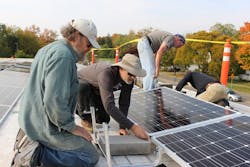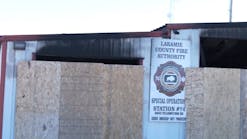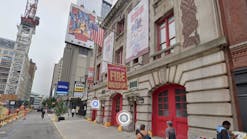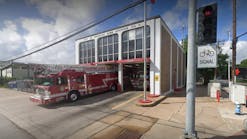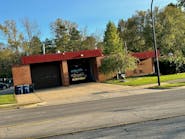The solar community in Ypsilanti, MI, has grown from near zero to over a megawatt in the past 10 years. The solar installation that pushed the city over the megawatt mark: a 50-kW solar installation on the roof of the Ypsilanti Fire Station. This project was made possible by combining an anonymous donation with volunteer labor, a committed city government, and a new way to capture the 30 percent Federal Renewable Energy Tax credit and depreciation for nonprofits.
Initial stages
Ypsilanti Fire Chief Max Anthouard and representatives from SolarYpsi—a grassroots effort dedicated to the use of renewable energy sources in Ypsilanti—discussed the idea of a solar roof for the fire station for several years before they could make it happen. During that time, SolarYpsi drafted designs and estimated installation costs. The trick was to find the funds to make it happen. While the City of Ypsilanti supports solar power, and passed a resolution (#2013-175) supporting a goal of 1,000 solar roofs by 2020, the city continues to struggle with its post-industrial economy, and had no extra funds available for this project. SolarYpsi searched for grants, but solar grants are far and few between.
When an anonymous donor pledged $25,000 toward the project, planning could finally begin in earnest. The donation was a great start, but with typical installation costing about $3/watt, this 50-kW installation could total $150,000. Undeterred, SolarYpsi pulled together volunteer labor and worked with the local solar supply company, McNaughton-McKay Electric Company, for a lower price on the material. The project was now within the city’s budget, and it agreed to fund $55,000 toward the project.
SolarYpsi posted the project to the public and collected quotes for the solar materials from multiple supply companies, a process that took several weeks to complete. Two bids included options where the material for the solar installation would be leased to the fire department for 6 years, and then the fire department would take over the ownership of the materials. This allowed the company supplying the solar panels, inverters and racking to retain ownership of the material and claim the 30 percent Federal Renewable Tax Credit, depreciate the material, and then pass the savings on to the fire department. The final cost of the material was now considerably lower and, combined with the donation and volunteer labor, meant the city portion was only $31,000.
Organizing the crew
With the bids in hand and the winner selected, the final list of parts was tweaked to add a few more racking components to provide some flexibility on the roof to get around obstacles. The supply company delivered the parts, unloading them behind the fire station.
The following day, Ypsilanti firefighters moved the material from the ground to the back of the roof using the bucket on the fire truck, while city employees moved material from the ground to the front of the roof using the bucket on their front-end loader. Having access to this equipment and the help of firefighters and city workers saved significant time and money on this project.
With all the material on the roof, SolarYpsi then put out a call for local able-bodied residents to help with the assembly of the racking and installation of the panels and optimizers used for the installation. Ypsilanti is fortunate to have a community willing to assist with projects, and about dozen people showed up on a sunny Saturday to help out.
The roof is flat, and with a safety barrier placed around the perimeter, volunteers—ranging from teenagers to senior citizens, from skilled worker to novices, from students to Mayor Amanda Edmonds and the fire chief—on the roof helping. Because the racking is highly repetitive work, once a few people saw how it was assembled, they could split off and work on a different part of the roof, allowing everyone to work in parallel and not get in each other’s way. All 176 panels, racking, ballast blocks and optimizers were installed in just seven hours.
SolarYpsi hired a professional solar contractor, John Wakeman from SUR Energy, to wire the strings, make the home runs to the inverters, and tie into the station’s three-phase, 208-volt electrical system. The contractor was also responsible for passing the electrical inspection and utility company, DTE Energy, commissioning.
The financial model
One of the interesting aspects of the project was working with Rob Rafson of Chart House Energy to lease the material instead of purchasing the material so the city could take advantage of the 30 percent Federal Renewable Tax Credit. This credit is typically available to businesses and homeowners who pay federal taxes each year, and it can greatly reduce the payback period of a solar installation. The trouble with nonprofits and municipalities is that they do not pay taxes, so they can’t take advantage of the credit. By having a third-party purchase the material and lease it to the nonprofit, the third party became the owner of the material and collected the tax credit. Chart House Energy will own the material for 6 years and then the City of Ypsilanti purchases the material at a greatly reduced fair market value (after tax benefits). Chart House Energy is also able to depreciate the costs of the material for even more savings. Chart House Energy then passes the bulk of the combined savings on to the city and keeps a portion as profit. One mistake was paying the solar contractor directly. Had the contractor been made a subcontractor to Chart House Energy, SolarYpsi could have also saved 30 percent on that portion of the project, too.
Further, Ypsilanti was fortunate to have an anonymous donor from outside the community who has confidence in SolarYpsi projects and continues to help fund solar projects in the city.
The fire house’s 50-kW solar installation should make about $20 per day in electricity, or about $7,323 per year. The city paid $31,000 toward the project and should recover their investment in less than 5 years. The panels will last at least 30 years, supplying free power for 25 of those years.
Winners all around
Everyone wins in this scenario. The donor wins knowing that their donation enabled 50-kw of solar power to be installed to offset the burning of fossil fuels and helped to build a stronger solar community. Chart House Energy wins by also helping to enable this project and making a small profit through its lease to the city. SolarYpsi wins by having one more solar roof toward its goal of a 1,000.
The City of Ypsilanti wins by saving money on the electric bill for the fire station. The fire department wins by learning firsthand how solar power works and will be using the fire station’s installation to conduct firefighter trainings for the county fire departments. The course will address the risks associated with fires involving solar power and steps to take to mitigate hazards. Further, the fire station’s solar installation pushed Ypsilanti over the one megawatt mark for solar power within the city. With a population of just under 20,000 people, this gives the city more than 50 watts per capita and would put it at #16 on the 2016 Environment America’s Shining City list.
Final thoughts
When the weather warms, there will be a ribbon-cutting ceremony to celebrate this project. The ceremony will be an opportunity to appreciate the community’s involvement and introduce the fire station as a showcase for neighboring communities. It will also provide a chance to educate the public about how solar works and how it can save money.
Check out a video of the installation here.
Dave Strenski
Dave Strenski is a principal engineer at Cray Inc. and the founder of SolarYpsi.org, a group of volunteers promoting solar power in the City of Ypsilanti, MI. He has degrees in survey, civil and mechanical engineering.
